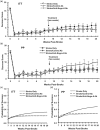Improved functional outcome after chronic stroke with delayed anti-Nogo-A therapy: A clinically relevant intention-to-treat analysis
- PMID: 28952904
- PMCID: PMC6077927
- DOI: 10.1177/0271678X17730994
Improved functional outcome after chronic stroke with delayed anti-Nogo-A therapy: A clinically relevant intention-to-treat analysis
Abstract
Many preclinical treatment strategies for stroke have failed when tested in human trials. Although the reasons for these translation failures are multifactorial, one potential concern is the statistical analysis of the preclinical data. One way to rigorously evaluate new therapies is to use an intention-to-treat analysis in preclinical studies. Therefore, in this study, we set out to evaluate the treatment efficacy of a potential clinically relevant therapeutic agent for stroke, i.e., anti-Nogo-A immunotherapy, using an intention-to-treat analysis. Adult rats were trained on the skilled forelimb reaching task and subsequently underwent an ischemic stroke. Nine weeks later, the rats either received intracerebroventricular anti-Nogo-A antibody, control antibody, or no treatment. Skilled reaching performance was assessed by a non-linear model using both an intention-to-treat and per-protocol analysis. Following testing, dendritic complexity was evaluated in the contralesional and perilesional sensorimotor cortex. Both intention-to-treat and per-protocol analysis showed that anti-Nogo-A immunotherapy resulted in statistically significant improved recovery on the skilled forelimb reaching task, although treatment effect was less (though statistically significant) in the intention-to-treat group. Improved functional performance was not shown to be associated with dendritic changes. In conclusion, this study provides evidence for the importance of using intention-to-treat paradigms in testing preclinical therapeutic strategies.
Keywords: Anti-Nogo-A; chronic; recovery; sensorimotor; stroke.
Figures






Similar articles
-
Cognitive recovery in the aged rat after stroke and anti-Nogo-A immunotherapy.Behav Brain Res. 2010 Apr 2;208(2):415-24. doi: 10.1016/j.bbr.2009.12.015. Epub 2009 Dec 24. Behav Brain Res. 2010. PMID: 20035795 Free PMC article.
-
Delayed anti-nogo-a therapy improves function after chronic stroke in adult rats.Stroke. 2011 Jan;42(1):186-90. doi: 10.1161/STROKEAHA.110.590083. Epub 2010 Nov 18. Stroke. 2011. PMID: 21088244 Free PMC article.
-
Rewiring of the corticospinal tract in the adult rat after unilateral stroke and anti-Nogo-A therapy.Brain. 2014 Mar;137(Pt 3):739-56. doi: 10.1093/brain/awt336. Epub 2013 Dec 18. Brain. 2014. PMID: 24355710 Clinical Trial.
-
Neuronal plasticity and functional recovery after ischemic stroke.Top Stroke Rehabil. 2008 Jan-Feb;15(1):42-50. doi: 10.1310/tsr1501-42. Top Stroke Rehabil. 2008. PMID: 18250073 Review.
-
Evaluating the effectiveness of anti-Nogo treatment in spinal cord injuries.Neural Dev. 2020 Jan 9;15(1):1. doi: 10.1186/s13064-020-0138-9. Neural Dev. 2020. PMID: 31918754 Free PMC article. Review.
Cited by
-
Improved Functional Outcome After Peripheral Nerve Stimulation of the Impaired Forelimb Post-stroke.Front Neurol. 2021 Apr 20;12:610434. doi: 10.3389/fneur.2021.610434. eCollection 2021. Front Neurol. 2021. PMID: 33959086 Free PMC article.
-
Early constraint-induced movement therapy affects behavior and neuronal plasticity in ischemia-injured rat brains.Neural Regen Res. 2019 May;14(5):775-782. doi: 10.4103/1673-5374.249225. Neural Regen Res. 2019. PMID: 30688263 Free PMC article.
-
Experimental pediatric stroke shows age-specific recovery of cognition and role of hippocampal Nogo-A receptor signaling.J Cereb Blood Flow Metab. 2020 Mar;40(3):588-599. doi: 10.1177/0271678X19828581. Epub 2019 Feb 14. J Cereb Blood Flow Metab. 2020. PMID: 30762478 Free PMC article.
-
Anti-Nogo-A Antibody Therapy Improves Functional Outcome Following Traumatic Brain Injury.Neurorehabil Neural Repair. 2023 Oct;37(10):682-693. doi: 10.1177/15459683231203194. Epub 2023 Oct 14. Neurorehabil Neural Repair. 2023. PMID: 37837331 Free PMC article.
-
A Potent Inhibitor of Aminopeptidase P2 Reduces Reperfusion Injury in Models of Myocardial Infarction and Stroke.J Pharmacol Exp Ther. 2022 Mar;380(3):220-229. doi: 10.1124/jpet.121.000875. Epub 2022 Jan 3. J Pharmacol Exp Ther. 2022. PMID: 34980660 Free PMC article.
References
-
- Mozaffarian D, Benjamin EJ, Go AS, et al. heart disease and stroke statistics-2016 update: a report from the American Heart Association. Circulation 2016; 133: e38–e360. - PubMed
-
- National Institute of Neurological D and Stroke rt PASSG. Tissue plasminogen activator for acute ischemic stroke. N Engl J Med 1995; 333: 1581–1587. - PubMed
-
- Berkhemer OA, Fransen PS, Beumer D, et al. A randomized trial of intraarterial treatment for acute ischemic stroke. N Engl J Med 2015; 372: 11–20. - PubMed
-
- Campbell BC, Mitchell PJ, Kleinig TJ, et al. Endovascular therapy for ischemic stroke with perfusion-imaging selection. N Engl J Med 2015; 372: 1009–1018. - PubMed
Publication types
MeSH terms
Substances
LinkOut - more resources
Full Text Sources
Other Literature Sources
Medical

